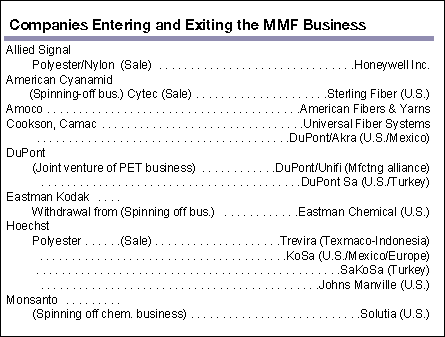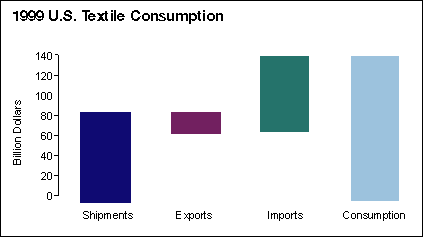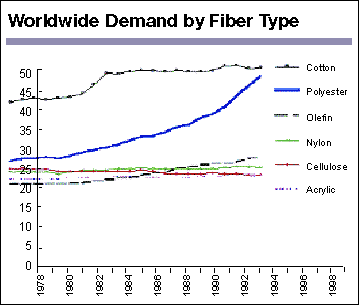The arrival of the new millennium has brought with it an array of challenges to the textile
industry, according to Eduardo Rocha, vice president and general manager for Houston-based KoSa.
But these challenges can be overcome by innovative alliances, marketing and technology.Rocha,
addressing the summer conference of the Textured Yarn Association of America Inc. (TYAA) in Myrtle
Beach, S.C., said the fibers sector, in particular, is facing limited profits because of the
escalating prices of raw materials caused by a significant increase in oil prices over the past few
years. Pressure from imports has impacted profit margins in the texturing segment. In the yarn and
fabric sector, imports are also a major obstacle to profitability.However, the opportunity exists
for textile manufacturers to capitalize on growing demand worldwide and to increase exports to both
established and developing economies, he said. Much of the opportunity will be in apparel and
accessories constructed from man-made fibers and yarns.Cotton production has flattened in the past
15 years, he said. With population growth and more demand for land for agricultural use, it is
anticipated worldwide growth of cotton will be limited. On the other hand, and due to its versatile
properties, polyester is, and will be, the growing fiber of the future, Rocha said. Since 1978,
olefin fibers have had the largest rate of growth 7.2 percent per year while demand for fibers such
as nylon has grown by 1 percent per year. Total fiber demand is currently about 120 billion pounds
per year, with polyester accounting for 39 billion pounds, of which 17 million pounds are staple
and 22 million pounds are filament. North America, Western Europe and China remain the largest
markets for fiber products, he said.

Table 1The United States, with a per capita consumption of 80 pounds, continues to lead the
world in fiber demand. Total textiles consumption in the United States accounts for about $130
billion per year. The per-capita income in the United States is approximately $20,000 per year,
Rocha said. With its high per-capita income and large total market size, the United States is the
target market for producers of textile goods worldwide. But if income per capita improves in other
regions, fiber demand will increase dramatically. The man-made fibers industry will then have the
opportunity to show its ability to adjust to rapidly changing circumstances.Export
OpportunitiesRocha said export opportunities will exist for U.S. companies in commodities, but the
real opportunity is in the specialty products where the United States enjoys worldwide recognition
for quality, marketing and branding key factors in capitalizing on the market for higher-end
products.The key issues impacting the future of the textile business and the opportunity for U.S.
companies to increase exports are:
- The United States has an open economy capital and technology flows freely around the
world. - World textile production capacity exceeds demand.
- The economy in Asia will continue to grow after the 1998 setbacks.
- Industry consolidation will continue.
There are different ways we can react on globalization, Rocha said. We know that this
represents increased competition and lower prices. We can ask for protection against unfair
advantages that some countries have subsidies, labor costs, taxes or we can show them how good we
are, generating new products and developing innovative technologies.The world is aligning in trade
blocs, and the United States has the opportunity to capitalize on some of them. NAFTA [North
American Free Trade Agreement] continues to be a good vehicle to increase trade, especially now
that the Mexican transition to democracy is advancing faster, he said. CBI [Caribbean Basin
Initiative] will be a benefit for apparel with U.S.A yarn and fabric content. WTO [World Trade
Organization] quotas for yarn, fabric and apparel will be phased out by 2005. China, currently the
largest man-made fiber producer in the world, is hardly investing today to be prepared for the
WTO.The end result is that consumers will benefit and the most competitive firms will prevail, he
said.Addressing overcapacity, Rocha said there were high expectations of large market growth over
the past decade, and most fiber producers, with a commodity mindset, invested in large facilities
to seize the opportunity. When growth slowed down, we ended up with a considerable overcapacity
throughout the world.

Imports double exports. However, a large part of the consumption is locally
produced.Companies began to focus on cost reduction and fought for market share, prices decreased
dramatically, and reinvestment economics disappeared. The natural consequence was the shutting down
of older equipment.Lessons learned from the past decade will allow us to focus on selective growth
in specialty niches and investment will flow for the most attractive opportunities, Rocha said. The
supply-demand balance will be healthier.With the Asian financial crisis, demand reduction put more
pressure on exporting countries in Asia to sell outside the region. For example, in 1998, domestic
textile consumption in Korea decreased almost 20 percent. During the same year, China, Hong Kong
and Korea exported about $45 billion in clothing, almost 25 percent of the world total.

Table 3With its large population and past economic performance, Asia has the potential
despite some setbacks to be the most important textile market in the world, Rocha said. This could
represent a good opportunity for innovative North American textile producers. With a sound Far
Eastern economy, North America will benefit.Consolidation To ContinueConsolidation of North
American companies alliances and joint ventures can capitalize on North Americas growing purchasing
power, improve utilization of capacity and focus on selective growth. Industry consolidation will
continue, he said, resulting in stronger companies and eliminating some of the fragmentation in the
value chain. It will also change some of the forces in the industry.With the state of the age of
global mega-competition, selection and concentration have become essential, he said. The end result
will be a North American industry with fewer players, but much stronger.Giant chemical firms, for
example, have withdrawn from the man-made fiber business, placing particular emphasis on life
science and specialty chemicals, with the hopeful expectation of growth and better profits. Other
companies have acquired new partners, and new manufacturers constantly enter the marketplace.In
1980, eight of the top 10 polyester fiber producers were North American and European companies (See
Table 1). By 1999, seven were Asian companies. These changes have altered the balance of polyester
fiber production worldwide, Rocha said. The Asian man-made fibers industry has grown enormously and
today accounts for nearly 70 percent of worldwide capacity.The consolidation of texturing equipment
manufacturers Barmag/ Saurer, Rieter/ICBT, etc. will result in the application of joint technology
to bring more innovation and better machines. This technology innovation must have a faster pace,
and the western hemisphere must be the driver, he said. For instance, the friction disk was
initiated in the 1970s. It is 30 years later now, and some other mechanism should come to innovate
the process.As well, he continued, the manufacturers of fibers will need to come up with new
methods for extrusion and spinning that results in better fiber performance and color
stabilization, and with a focus on customer and market needs.The development of a commercial
bicomponent fiber that will be textured by heating effects will take a share of the future textile
market. Specialty texturing certainly opens an opportunity to produce a vast number of new
products. Productivity must be improved, he said, and average speed should increase.We must look at
how we will win, not only at how we will defend our North American market, he said. A modernization
process for polyester spinning and for texturizing machines is needed to improve productivity. A
key issue is the knowledge, expertise and talent of the people involved in the process.E-commerce,
he said, will certainly be a driver that will revolutionize the textile transactions, with more
global access to producers and consumers.A stronger alliance among fiber producers, texturizers,
textile manufacturers and distributors is needed to improve the entire value chain. The industry
must continue to design programs to insulate at least some of its products from direct imports,
focusing on product and market innovation. Areas of concentration should include enhanced comfort,
aesthetics and performance.In general, a change is needed from volume to value, from mass
production to niche markets and to research-based products, he said. The best way to predict the
future, he said, quoting legendary manage-ment scholar Peter Drucker, is to create it.
November 2000




